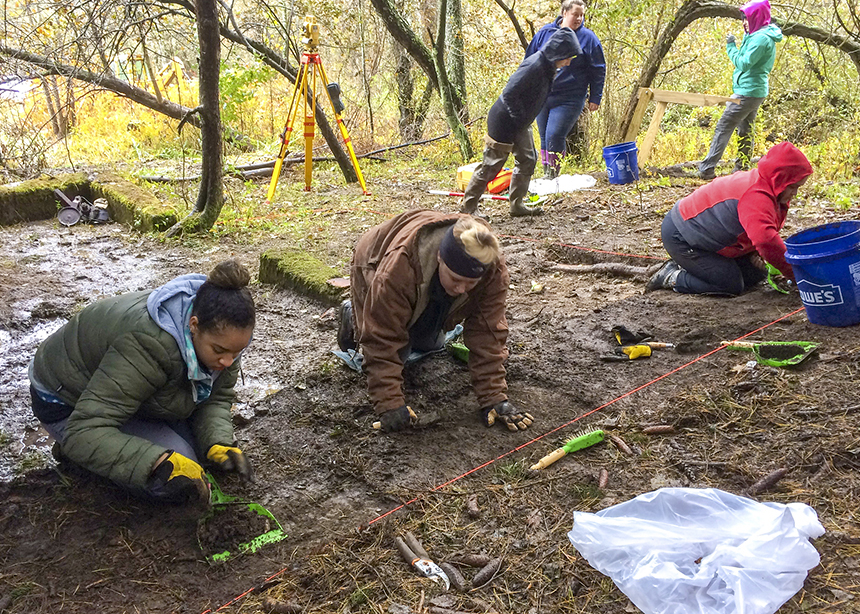Listening to the Past
Sep 30, 2019 2:00 PM
by Robert Spahr '13
"I imagined things would be starker than they were,” Flood said. “One of the first things we found on the surface was a gas-powered washing machine mount – a luxury item. We didn’t find a washboard that somebody would be slaving over. A lot of the material we recovered in the house is sort of pointing in that (more prosperous) direction.”
Some discoveries were toys, like a child’s horse and rider, chess pieces or a Japanese- made spinning top. Others pointed to pride in appearance, like a shoe polish tin, the shank from a high-heeled shoe, a lapel pin, shards of pottery and finely made buttons.
Digging into the past resonated with Flood’s students.
“On my first day working at Kempton, I located the back wall of the home we were digging up – a major find,” said senior earth science major Louis Walden, who also helped Dr. Matt Ramspott, assistant professor of geography, survey the site by drone. “It was pretty neat to gain some drone experience as well. Overall, the project was an amazing experience. Archaeology should be a permanent part of FSU’s Geography Department.”
For Shealee Brown, a senior geography major, there was something special about connecting with the people who’d lived there through the items they’d left behind.
“The experience of unearthing artifacts of someone’s life was indescribable,” Brown said. “The first thing I discovered was a rusty nail. While that seems so little now, it was exhilarating to have found something It made me realize I had the ability to tell the story of the residents with these discoveries.”
This spring, Brown returned to Kempton to interview current residents, assembling their recollections and passed-down memories about the roles of women in daily life during the mine’s heyday. She will eventually combine those interviews with the uncovered artifacts and research into other Appalachian mining towns to retell the everyday history of Kempton.
Unlike the Depression-era photographers on “poverty safari,” those involved in the Kempton research intend to let its findings speak for themselves.
“Archaeology is not a science of ‘I want to find this,’ and then you discover it. You just have to present what you find. What we’re finding is painting a different story than has been painted for these people,” said Flood. “That’s pretty neat.”
Flood’s students found the experience pretty neat, too.
“I had never been exposed to archaeology before Dr. Flood’s class,” Walden said. “I had a great time volunteering on the Kempton project and definitely gained some knowledge in archaeology that could be used on my resume.”
For Brown, the experience convinced her to explore a career in archaeology.
“Working on this project helped me discover that this is what I want to do with my life,” said Brown. “This opportunity means that I now have tangible experience in archaeology, which will help me get into my future career.”
Flood highlighted the importance for Appalachian people to reclaim their own stories, rather than believing those historical depictions of their culture that largely came from outsiders visiting Appalachia.
“Maybe we need to be careful of believing the story when the source hadn’t taken into consideration what people’s lives actually look like. … There was a lot more to the story,” said Flood. “To think of yourself as less-than or impoverished is something Appalachia has had to grapple with for a long time. This seems like a good way to rewrite that narrative through what was left behind.”
Kempton’s Future
There is much work still ahead for the Kempton Historical Archaeology Project. Flood hopes to establish a museum in Kempton to house the artifacts found on site and tell the story of the townspeople. He also hopes to raise awareness of an ongoing environmental hazard in Kempton – the problem that first brought Kempton to Flood’s attention – acid mine drainage (see related story).
The project’s volunteers hope their work, in addition to telling a more complete story of Appalachian coal town life, will also educate people about the aquatic health of the Potomac River and move them to act and advocate to mitigate acid mine drainage in the North Branch.
To learn more about both projects, visit the Kempton Historical Archaeology Project web site.
 Artifacts collected in the excavations at Kempton tell the story of domestic life in this Appalachian coal town in the first half of the 20th century
Artifacts collected in the excavations at Kempton tell the story of domestic life in this Appalachian coal town in the first half of the 20th century


